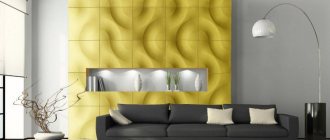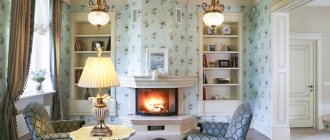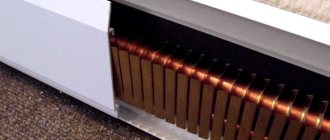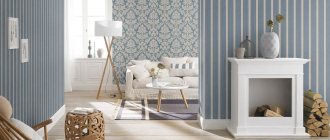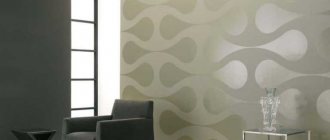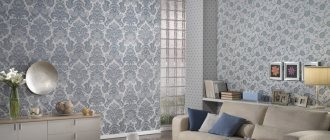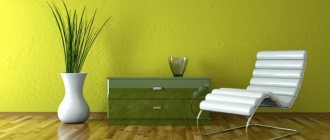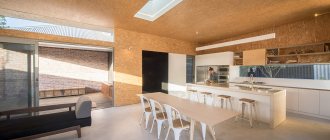Modern finishing materials amaze with their diversity, but designers still manage to surprise us by offering new fresh solutions. One of the latest trends is 3D panels in the interior. The unique building material used for wall decoration opens up limitless horizons for interior design.
Room design with 3D panel
Bedroom interior with 3D panel
Gorgeous large 3D panel in the interior
What types of panels are there?
Manufacturers offer a wide range of 3D slabs, because wall panels are made from various materials that have their own advantages and disadvantages.
- Gypsum panels. Flexible and plastic gypsum allows you to create a wide variety of designs and textures, and a wall made up of several such panels seems solid, since the cracks between them can be easily covered with the same plaster. In addition, this material can be painted. The disadvantage is the significant weight of gypsum panels compared to plastic or MDF.
- Plastic panels. Considered a budget option. In addition, they are moisture resistant and lighter. Wall panels made of plastic can be painted, and their installation is quite simple: they are attached to the wall using glue or a metal frame. The downside is their flammability, which makes it impossible to use 3D panels for walls in the living room interior directly next to the fireplace.
- MDF panels. Made from wood fibers using the gluing method. The material is environmentally friendly and reliable, but much cheaper than wood. It features high performance characteristics and reliability. Used for decorating rooms with humidity not exceeding 80%. Relief panels made of compressed wood fibers are attached to the wall using brackets. The advantages include high noise and heat insulation. MDF wall panels can be painted and laminated. Among the minuses, we highlight the need for careful care of them, since over time it somewhat loses its appearance.
- Bamboo panels. Natural wood materials are also popular. Bamboo is most often used for the manufacture of volumetric decorative slabs. Low cost, environmental friendliness, ease of installation and excellent appearance open up many opportunities to use bamboo 3D panels in the interior. However, unfortunately, such panels are short-lived and have low moisture resistance, so they are not very suitable for the bathroom or kitchen. They are usually used in bedrooms or living rooms.
- Aluminum panels. A three-dimensional image on the surface of aluminum plates is obtained by perforation, and the top is covered with a special film that serves to protect the panel from corrosion. Therefore, aluminum wall panels are quite moisture resistant. In addition, they are fire-resistant and very durable. Therefore, it is permissible to use aluminum 3D panels for walls in the interior of a living room with a fireplace. This material does not require special care and practically does not get dirty, however, such luxury costs accordingly.
Room interior with 3D panel
Room interior with 3D panel
Squares in 3D panels
To make it easier to decide on the choice of panel material for your interior, here is a comparison table:
| Gypsum | Plastic | MDF | Bamboo | Aluminum | |
| Ease | — | + | + | + | + |
| Moisture resistance | — | + | + | — | + |
| Fire resistance | + | — | — | — | + |
| Durability | + | + | — | — | + |
| Price | Depends on the complexity of the drawing | Average | Average | Low | High |
| Installation | Self-tapping screws | Glue or metal frame | Brackets | Glue | Special profiles |
Living room interior with 3D panel
Living room with 3D panel
Bedroom with 3D panel
See alsoModular paintings in the interior, sizes and features.
Materials
Now let's look at what wall panels for interior decoration are made of. Of course, their choice is already wide due to different shapes, colors, etc. But the raw materials for manufacturing make it even bigger. So, panels are made from:
- gypsum;
- glass;
- wood;
- metal;
- plastic;
- bamboo
It is impossible to say which panel material will be the best. It all depends on each specific case. To make it easier to understand what this or that panel is, let’s look at them separately.
Glass
A relatively new type of 3D panels. You almost never see them in living rooms and bedrooms - other analogues are more suitable there. But in bathrooms and kitchens, tempered glass surfaces look great. The finish lasts a long time and does not require special care. Moreover, such glass structures can create a stunning look. Holes for fasteners are made at the factory, since it will not be possible to drill through the material without consequences. By the way, the glass itself is tempered, which is also good: even if part of the finishing breaks, the fragments will not have sharp edges, so they are also unlikely to cause serious harm to health.
The thickness of the glass panels is small, approximately 4-6 mm. This is explained by the fact that glass is a heavy material, so it is not worth making the elements thicker. Manufacturers offer different sizes, from 20*30 cm to 2*2.5 m. Since kitchens and bathrooms are oversized rooms, it is better to give preference to smaller elements.
One of the main disadvantages of the glass analogue is the price. One square meter costs a lot, and full-size panels cost even more. Therefore, they are often used to decorate a small sector: for example, in the kitchen it is a work area.
Wooden
This type is used specifically in rooms and bedrooms. To ensure that the finish is not afraid of moisture, it is treated with wax or varnish. And yet, it is better not to use such panels in the bathroom, since the aesthetic appearance they create is of no use there. They are also not recommended in the kitchen, especially above the stove, since wood is a flammable material.
Such panels have many advantages. They are environmentally friendly, create a favorable climate and a presentable interior. But their cost is very high. One of the reasons for this is the type of wood that is used for manufacturing. These are ash, beech, maple, wenge, walnut and others. As you can see, the breed is not an ordinary one. But, if money is not the main thing, then it’s worth it.
In addition to three-dimensional wood finishes, this also includes analogues from MDF, fiberboard and chipboard. They are made by pressing waste, due to which the price of the material is reduced. If there is high humidity in the room, it is better to choose the MDF option, since the other two are afraid of moisture.
Plaster
Another fairly common option. And all because such panels can create a seamless finish. More accurately, there will be seams, but they can easily be sealed with the same plaster, making the wall look solid.
Gypsum is an elastic material, so various textures can be easily applied to it. It can also be painted (unlike, for example, glass). Like wood, gypsum can boast of being environmentally friendly, but at the same time, it is not flammable (by the way, gypsum is also not afraid of elevated temperatures).
Gypsum rear wall panels are suitable for rooms with normal humidity levels (for example, children's rooms or bedrooms). However, they can also be used in bathrooms and kitchens, but for this you need to buy special types that have undergone appropriate processing. The standard size is 60*60, although smaller panels can be purchased. The thickness ranges from 40 to 60 mm, but the relief doubles these figures.
If you are not satisfied with the gypsum panels sold in the store, you can make them yourself. To do this you will need a mold and plaster.
Plastic
This option is for those who do not have large funds. In addition, polymer elements have a number of other advantages: they weigh little, are easy to transport and install, and are easy to care for. Thus, plastic is not afraid of water, so such 3-D panels can be used to decorate, for example, a bathroom. They also do not absorb dirt, so cleaning them will be easier. Externally, the finish resembles plaster, since the polymer components are also cast in molds. Therefore, plastic rear panels for walls also have a complex and beautiful relief.
With all these advantages, there are also a couple of disadvantages. So, plastic is a rather fragile material, which is not good. In addition, he does not like high temperatures; Therefore, plastic trim should not be used near fireplaces, or in the kitchen near the stove.
Metal
Aluminum panels also have their popularity. They are not afraid of moisture, fire, high temperatures, and can withstand impacts that can destroy plastic, wooden or plaster counterparts. Like glass ones, they are used in kitchens near hobs. You can also use non-combustible panels to decorate areas near the fireplace.
The volume of the pattern on aluminum 3D panels is created by perforation. To prevent the metal from being afraid of moisture, the surface is laminated with a polymer film. By the way, cleaning this finish is also easy. True, the cost of this option is appropriate. The maximum size of one element is 1.2*3 m.
Bamboo (eco-panels)
For those who are wondering why these panels are not classified as wood, we remind you that bamboo is a grass. True, this, of course, does not negate the environmental friendliness of the material. Externally, such panels resemble plaster, but they weigh lighter. They are also easier to install: if some analogues require the assembly of a frame, then here you can get by with liquid nails or adhesive foam. True, such a finish cannot boast of resistance to mechanical stress or moisture. Therefore, like wood, bamboo 3d panels are best used in bedrooms and not used in bathrooms. In addition, they will need to be additionally treated, for example, with water-repellent varnish. The thickness of the bamboo finish is small - from 15 to 25 mm, and the cost is comparable to its MDF counterparts.
Pros of 3d panels
- Versatility. The possibilities for using relief panels are almost limitless. They are used for decoration or as partitions when zoning rooms. Thanks to volumetric slabs, you can hide imperfections and unevenness of walls, hide insulation or various communications.
- Originality. Decorative wall panels can create a bold design and unique appearance of the room. The use of such finishing materials began relatively recently, so not everyone has yet had time to appreciate their advantages, and 3D panels for walls in the interior of an apartment will be a rather unusual solution that will definitely surprise your guests.
- Durability. Most wall panels are made from high quality materials.
- They are usually moisture-resistant, durable and resistant to mechanical stress, which guarantees a long service life of the panels.
- Easy to install. Installation of the panels does not require additional preparation, as well as special tools or skills. To install the slab, you do not need to bring the wall to perfect condition, because installation can be done even on uneven surfaces. You can decorate the walls of a room with decorative slabs without involving professionals using glue or liquid nails.
- Heat and sound insulation. Three-dimensional patterns on panels made of various materials serve for decoration, but can also play the role of insulation or soundproofing partition.
Wavy 3D panel in the interior of a room
Room interior with 3D panel
Large room with a beautiful 3D panel
See also Stucco molding in the interior, photo.
Criteria for choosing volumetric wall panels
When choosing 3D panels, focus on:
- quality;
- price;
- design.
To purchase high-quality wall finishing materials, you should rely on reviews from real customers. Each element should be carefully examined. There should be no chips or other defects on its surface. Products from leading manufacturers and the availability of certificates confirming quality are preferred.
Cost is a relative indicator. You will have to pay a lot more for a designer product. At the same time, the service life and quality will remain unchanged.
The design of the slabs is selected taking into account the purpose and characteristics of the room. For the kitchen you can choose a floral ornament, for the bathroom – spherical bubbles.
Cons of 3d panels
- Difficulty of perception. It is recommended to place relief panels on only one wall or part of it. Otherwise, they can overload the interior and also tire a person.
- The need for regular cleaning. A three-dimensional pattern on the walls will accumulate dust and, therefore, require constant cleaning. When installing 3D panels in a room, you need to be completely sure that you can provide them with such care. Otherwise, the accumulated dust will not only spoil the effect of the three-dimensional image, but can also cause allergies.
- Stylistic features. Relief panels are a rather complex effect that requires maintaining the stylistic unity of the room. In many interiors, such a solution will look too pretentious or inappropriate.
- Difficult to replace. If one panel fails, it will be quite difficult to find a replacement, so it is better to stock up on several extra panels in advance.
Unusual 3D panel in the interior of a room
Room design with 3D panel
Light 3D panel in the interior of the room
See alsoOriginal decor with butterflies: photos, tips, materials
Disadvantages of 3D interior
All types of 3D compositions have three main disadvantages:
- Dust settles on the relief textures of three-dimensional slabs, which negatively affects the visual perception of the spatial effect. Despite how easy it is to care for the panels, you have to constantly wet wipe all the details of the design;
- Oversaturation of compositions with three-dimensional asymmetrical details is not always beneficial for our nervous system, therefore such mosaics are undesirable for permanent premises;
- You should not excessively use 3D wall panels with contrasting colors of bright colors, since the rich optical three-dimensional effects they create quickly tire and irritate the human eye.
Application options
Three-dimensional technologies are actively being introduced into interior design, striking the imagination with unusual shapes and transforming space. Volumetric panels serve to perform aesthetic and functional tasks. They are actively used for zoning rooms, creating partitions, masking communications or uneven walls.
Relief images with a volume effect can visually increase the size of the living room and give the interior freshness and novelty. A horizontally placed pattern will visually elongate and expand the room, while vertical stripes will raise the ceiling level.
Decorative wall panels are also used as heat and sound insulation or highlighting functional areas. They will create a wonderful backdrop for a home theater, and made of fireproof materials - even for a fireplace.
Soft 3D panel in the interior of the room
Beautiful 3D panel in the interior of the room
Living room design with 3D panel
See alsoDIY room decor: ideas, photos
What is 3D wallpaper
3D wallpapers are canvases with a three-dimensional image. They create a feeling of presence and visually expand the space. The image seems to go beyond the walls and acquire volume.
In the interior, such canvases look vibrant and expensive. Thanks to a correctly selected image, the room takes on a completely different look and is filled with a new atmosphere .
This finishing material has different classifications and is absolutely harmless. Every year new varieties appear, for example, backlit or glow-in-the-dark wallpaper.
Where to use
The modern range of 3D panels allows you to match them to any style. Three-dimensional images made of plaster will fit perfectly into a classic interior, which will harmonize perfectly with elements such as columns and stucco molding. Modern apartments in a minimalist style involve the use of metal or glass, while in ethnic interiors natural wood is preferable.
To emphasize the three-dimensional effect, lighting with spotlights or LED strips is used.
Practical and convenient 3D panels are gaining more and more popularity and are used in almost any room: living rooms, bedrooms, kitchens, bathrooms and children's rooms. Moreover, the scope of their application depends on the material from which they are made. Natural wood panels, as well as gypsum decorative boards, are usually not placed in rooms with high humidity, and aluminum panels are used to decorate bathrooms and kitchens. The most environmentally friendly bamboo and other types of wood are used in bedrooms, children's rooms and living rooms, and universal three-dimensional images made of plastic are suitable for any interior.
Cladding fireplace niches with volumetric panels made of non-combustible materials is very popular, and in bedrooms 3D panels are usually installed on the wall behind the bed, achieving the effect of a three-dimensional volume of the room.
Bedroom interior with 3D panel
Wavy yellow 3D panel in the interior of the room
White 3D panel in the interior of the room
See alsoOld “suitcases” in interior design
Designer lifehacks for using 3D panels in the interior
1. Big to big
Spacious rooms “ask” for complex patterns and large designs. The larger the room, the larger the three-dimensional image should be and vice versa.
2. Don't overdo it
Three-dimensional wall decoration is already a great artistic advantage for interior decoration. When there is a lot of it, you should not use acidic or too bright colors, unless this is a special technique, as in the pop art style.
3. The problem of darkness
If the 3D panels in the room turn out to be too dark and unnoticeable, you need to put an LED strip around them or introduce spotlights.
4. Photo panels
The choice fell on a three-dimensional panel with a photo or other image applied to the entire art object, then it is worth moving away from it other decorations in the room that take over the attention, if they are, of course, not part of the idea.
5. Texture
Sharp, intricate geometric shapes look better in dens, offices, kitchens and living rooms, while shallow ones with soft lines look best in bedrooms.
6. Space solution
There is a lot of space - you can use matte shades of 3D panels, little space - it is better to choose glossy products that visually expand the space.
Installation methods
The ease of installation of wall panels is one of their main advantages. Even a novice who has never done repairs can do such simple work.
Installation of 3D panels does not require any preliminary preparation of the walls. You just need to choose a location. The ideal option is to glue the panels with glue or liquid nails, however, this solution is only appropriate on almost flat walls with acceptable small defects. If the surface is not ideal, then it is better to use metal lathing to install the panels.
Room interior with 3D panel
Wavy 3D panel in the interior of a room
Room interior with 3D panel
White 3D panel in the room
It is recommended to think in advance about how the drawing will be positioned. To do this, first estimate on a horizontal surface what it will look like.
If installation is done on your own, then give preference to decorative panels that have special grooves for fasteners, this way you will achieve tighter joints.
Please note the panels are made to order. With their help, you can create a truly unique design that suits your interior in all respects.
See also: Limitless finishing possibilities: decorative plaster on interior walls
Advantages and disadvantages
3D panels look so original that they completely transform the room and set the main tone for it. They have many other advantages:
- ease of installation - high-quality glue is enough to fix the lamellas; even a beginner can handle the job;
- thermal insulation - panels reduce heat loss from the room;
- sound insulation - the finish prevents the penetration and spread of loud sounds;
- moisture resistance - many types of panels are not afraid of water, they can be washed even with non-aggressive household chemicals;
- harmlessness - this type of finishing is safe for internal use and does not emit toxins;
- fire safety - high-quality 3D panels are coated with a special impregnation that does not support combustion and stops smoke formation;
- strength - it is almost impossible to damage some lamellas mechanically;
- wear resistance - this type of finish lasts for many years;
- resistance to low temperatures, as well as temperature changes - many panels are suitable for unheated rooms.
The main disadvantage of three-dimensional wall panels is their high cost. Some raw materials for their production are very expensive, which affects the final price of the coating.
Not all types of finishes can be washed. For example, gypsum panels may lose their attractiveness after washing. If the material has a pronounced relief, then deep convexities and concavities will inevitably become dusty.
3D panels are perceived differently by people. For some, they can cause negative associations, dizziness, headaches and irritability (similar to the 3D effect in movies). They must be used carefully and due to the difficulty of combining with other materials.
If individual slats are damaged, replacing them will be problematic. You will have to purchase neighboring elements to recreate the design. It is best to use three-dimensional wall panels in spacious rooms, since they will not provide the desired effect in a cramped room.

